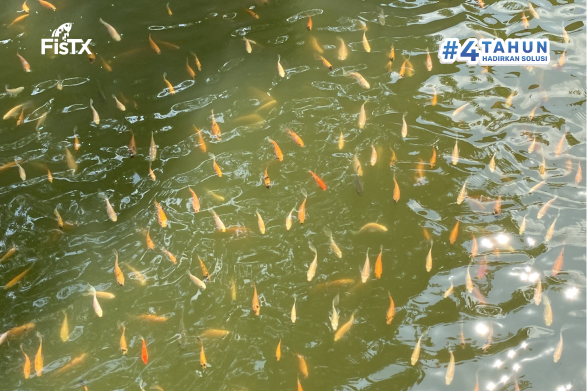
Wisely Choose Seedlings for Successful Shrimp Farming
Seedlings, abbreviated as benur or shrimp seedlings, play a crucial role in shrimp farming. Shrimp seedling production in Indonesia reached 40-45 billion in 2021, but this number has not been able to boost national shrimp production. National shrimp production in 2021 was better than the previous year, increasing from 1.11 million tons to 1.21 million tons, or about 9.2%. However, national shrimp production tends to decline compared to 2017, which was 1.37 million tons. This decrease is partly due to the increasing incidence of shrimp diseases.
The high levels of ammonia or organic matter in water will lead to the dysfunction of metabolic systems, respiration, immune system, and growth, affecting the damage to several organs such as gills, hepatopancreas, and intestinal layers. Therefore, to minimize the presence of ammonia and organic matter in water, farmers can take several measures, one of which is through the application of probiotics such as Bacillus sp. which can suppress the presence of vibrio in water and support the optimal growth and development of vannamei shrimp.
The suppression of pathogenic bacteria by Bacillus sp. occurs because of its ability to enhance shrimp immunity against pathogens in water. Additionally, Bacillus also plays a role in optimizing shrimp growth, feed efficiency, and can produce antimicrobial substances called bacteriocins, thus enhancing shrimp immunity.
Bacteriocins are antimicrobial polypeptide or protein substances produced by microorganisms that are bactericidal, able to kill pathogens in water by inserting into the target membrane, causing the cell membrane function to become unstable and leading to cell lysis. Given the various benefits provided by Bacillus bacteria, it can be concluded that Bacillus can assist in the optimization process of vannamei shrimp farming.
Year after year, shrimp diseases have evolved from viral attacks in the early 1990s such as WSSV in the windu phase, then IMNV in 2015, and evolved into diseases originating from bacteria and fungi such as AHPND and EHP which developed with EMS (Early Mortality Syndrome) symptoms at the beginning of cultivation and RMS (Running Mortality Syndrome) in the middle of cultivation. Therefore, besides maintaining water quality and cultivation structures, wise seedling selection is needed before stocking.
Good and quality seedling selection is the key to successful farming. Because the biggest cost in farming is dead shrimp. The impact is when shrimp die, the price will drop or even become unsellable in the market. Ironically, those dead shrimp have consumed feed, medications, and enjoyed the water treatment given, resulting in high production costs in Indonesia compared to other countries. The cost of seedlings in shrimp grow-out production is around 7-11%, but it has a Pareto effect of 70-80%, so choosing good and healthy seedlings can result in better harvests.
Good and healthy seedling selection can be done by scoring seedlings conducted by hatcheries, either through stress tests, bolitos tests, uniformity tests, and reinforced with PCR, either nested PCR or RT PCR. Currently, RT PCR can provide more accurate PCR results because of its ability to capture smaller virus copies, even up to 5 copies/virus implicated with CT Value. The smaller the CT value, the larger the virus value. This test is more accurate than nested PCR and should be done by an independent laboratory so that the seedlings are tested professionally and integrated. Disease-free seedlings are an absolute requirement for seedlings to be accepted by consumers.
The collaboration between accurate, professional, and independent lab testing with hatcheries will provide good benefits for hatcheries and farmers as well as national shrimp production, thus providing competitive advantages in production costs that affect shrimp selling prices. Good and disease-free seedling selection needs to be supported by optimal nutrition through the provision of the best nutrients such as live feed like artemia, which is pathogen-free. Artemia is a complete and perfect nutrient that can be easily absorbed by shrimp during the golden period of cultivation, which is DOC 1-3 days, reducing the use of artificial feed at the beginning of cultivation and maintaining water so that performance does not decline at the beginning of cultivation, causing EMS.
The higher price of seedlings compared to the general price becomes an attraction for farmers, but the long-term effects can have negative impacts. Early checking of seedlings using accurate RT PCR may not significantly increase the price of seedlings but has a lower long-term risk impact by knowing that the seedlings are safe and can provide good harvests. The price comparison of seedlings in Indonesia ranges from 40-60 rupiah/head, which is cheaper than in India with prices of 0.38-0.55 Rupees or about 71-102 rupiah/head. Interestingly, shrimp prices in India are cheaper than in Indonesia. This is something to reflect on. India has been able to surpass Indonesia, Vietnam, and Thailand as vannamei exporters with competitive prices. The combination of early disease testing in seedlings has a significant impact on shrimp farming success, along with the provision of the best nutrients such as live feed like artemia, which provides a double effect on shrimp farming itself. FisTx, as a technology company that has collaborated with several hatcheries, will introduce super larvae as one of our solutions for disease-free seedlings and provide optimal growth and immunity through collaboration with Cek kolam and Invebio to provide disease-free seedlings and complete nutrients that are easily absorbed by shrimp.
Read More Articles

More Productive Tilapia Farming with Oxygen Optimization
21 August 2025

Pangkep State Agricultural Polytechnic and Fistx Indonesia Establish Cooperation to Develop a Centre of Excellence for Ornamental Coral Cultivation
15 December 2025

Understanding the Influence of Ammonia in Shrimp Cultivation
26 July 2023